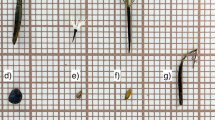Abstract
Harvester ants have traditionally been considered as seed predators that negatively affect plants. In some cases, however, they can also act as positive seed dispersers. During field observations, we noted that a portion of Psoralea bituminosa seeds that were collected and carried to the nest by the granivorous harvester ant Messor barbarus were discarded intact in refuse piles outside the nest. We analyzed and compared the physical characteristics of size, mass and toughness in P. bituminosa seeds from two different origins: intact seeds found in the ant’s refuse piles and seeds collected directly from the plants. Seeds from refuse piles were similar in width but lighter and tougher than seeds from the plant. Our results point to a mechanical defence based on seed toughness to avoid predation by M. barbarus and suggest that an elevated proportion (~69%) of the seeds produced by P. bituminosa could be too tough to be consumed by this ant. These transported but uneaten seeds could benefit by being moved far from the mother plant and this could act as a selective evolutionary pressure towards tough seeds.



Similar content being viewed by others
References
Andersen AN (1988) Dispersal distance as a benefit of myrmecochory. Oecologia 75:507–511
Baroni Urbani C (1992) Factors affecting seed preference among old world harvester ants of the genus Messor. Ethol Ecol Evol 2(Special Issue):73–80
Beattie AJ (1985) The evolutionary ecology of ant–plant mutualisms. Cambridge University Press, New York
Bolós O (1962) El paisaje vegetal barcelonés. Universidad de Barcelona, Barcelona
Boyd RS (1996) Ant-mediated seed dispersal of the rare chaparral shrub Fremontodendron decumbens (Sterculiaceae). Madroño 43:299–315
Danin A, Yom-Tov Y (1990) Ant nests as primary habitats of Silybum marianum (Compositae). Plant Syst Evol 169:209–217
Detrain C, Tasse O (2000) Seed drops and caches by the harvester ant Messor barbarus: do they contribute to seed dispersal in Mediterranean grasslands? Naturwissenschaften 87:373–376
Howe HF, Smallwood J (1982) Ecology of seed dispersal. Annu Rev Ecol Syst 13:201–228
Hughes L (1990) The relocation of ant nest entrances: potential consequences for ant-dispersed seeds. Aust J Ecol 16:207–244
Janzen DH (1982) Removal of seeds from horse dung by tropical rodents: influence of habitat and amount of dung. Ecology 63:1887–1900
Kaspari M, Weiser MD (1999) The size-grain hypothesis and interspecific scaling in ants. Funct Ecol 13:530–538
Knoch TR, Faeth SH, Arnott DL (1993) Endophytic fungi alter foraging and dispersal by desert seed-harvesting ants. Oecologia 95:470–473
Levey DJ, Byrne MM (1993) Complex ant–plant interactions: rain forest ants as secondary dispersers and post-dispersal seed predators. Ecology 74:1802–1812
Lucas PW, Peters CR, Arrandale SR (1994) Seed-breaking forces exerted by orangutans with their teeth in captivity and a new technique for estimating forces produced in the wild. Am J Phys Anthropol 94:365–378
MacMahon JA, Mull JF, Crist TO (2000) Harvester ants (Pogonomyrmex spp.): their community and ecosystem influences. Annu Rev Ecol Syst 31:265–291
Majer JD, Lamont BB (1985) Removal of seed of Grevillea pteridifolia (Proteaceae) by ants. Aust J Bot 33:611–618
O’Dowd DJ, Hay ME (1980) Mutualism between harvester ants and a desert ephemeral: seed escape from rodents. Ecology 61:531–540
Pulliam HR, Brand MR (1975) The production and utilization of seeds in plains grassland of southeastern Arizona. Ecology 56:1158–1166
Reyes J, Fernández-Haeger J (1999) Sequential co-operative load transport in the seed-harvesting ant Messor barbarus. Insect Soc 46:119–125
Rissing SW (1986) Indirect effects of granivory by harvester ants: plant species composition and reproductive increase near ant nests. Oecologia 68:231–234
Rodgerson L (1998) Mechanical defence in seeds adapted for ant dispersal. Ecology 79:1669–1677
Whitney KD (2002) Dispersal for distance? Acacia ligulata seeds and meat ants Iridomyrmex viridiaeneus. Austral Ecol 27:589–595
Wilcock C, De Almeida C (1988) The flora of the Algarve. Plants Today 1:151–157 (September–October)
Acknowledgements
This study was financed by the Ministry of Education and Science-FEDER (CGL2004-05240-C02)). All the experiments performed comply with current Spanish laws.
Author information
Authors and Affiliations
Corresponding author
Rights and permissions
About this article
Cite this article
Oliveras, J., Gómez, C., Bas, J.M. et al. Mechanical defence in seeds to avoid predation by a granivorous ant. Naturwissenschaften 95, 501–506 (2008). https://doi.org/10.1007/s00114-008-0349-0
Received:
Revised:
Accepted:
Published:
Issue Date:
DOI: https://doi.org/10.1007/s00114-008-0349-0




